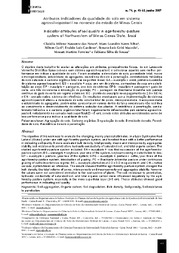Atributos indicadores da qualidade do solo em sistema agrossilvopastoril no noroeste do Estado de Minas Gerais.
Atributos indicadores da qualidade do solo em sistema agrossilvopastoril no noroeste do Estado de Minas Gerais.
Author(s): NEVES, C. M. N. das; SILVA, M. L. N.; CURI, N.; CARDOSO, E. L.; MACEDO, R. L. G.; FERREIRA, M. M; SOUZA, F. S. de
Summary: Resumo: O objetivo deste trabalho foi avaliar as alterações em atributos, principalmente físicos, de um Latossolo Vermelho Distrófico típico sob uso com sistema agrossilvopastoril, e selecionar aqueles com melhor per- formance em indicar a qualidade do solo. Foram avaliadas a densidade do solo, porosidade total, macro e microporosidade, estabilidade de agregados, resistência do solo à penetração, condutividade hidráulica do solo saturado e carbono orgânico total nas seguintes áreas: EA – eucalipto + arroz, primeira sucessão do sistema agrossilvopastoril; ES – eucalipto + soja, ano um do sistema, semeadura da soja em substi- tuição ao arroz; EP - eucalipto + pastagem, ano dois do sistema; EPG - eucalipto + pastagem + gado de corte, ano três do sistema e introdução do pastejo; PC - pastagem de Brachiaria brizantha sob pastejo contínuo de gado de corte em regime extensivo; EC - plantio de eucalipto no espaçamento de 2,0 x 3,0 m; e CN - cerrado nativo, sistema de referência. Os resultados mostraram que a implementação do sistema agrossilvopastoril alterou a densidade do solo, volume total de poros, microporosidade, macroporosidade e estabilidade de agregados, porém estes apresentaram valores dentro da faixa considerada não restritiva ao crescimento e desenvolvimento do sistema radicular das plantas. A resistência à penetração, condu- tividade hidráulica e o carbono orgânico total foram negativamente influenciados pelo sistema agrossilvo- pastoril, notadamente na camada mais superficial (0 – 5 cm), sendo estes atributos considerados como de boa performance para indicar a qualidade do solo. Abstract : The objective of this work was to evaluate the changing, mainly physical attributes, in a typic Dystrophic Red Latosol (Oxisol) under use with agri-forestry-pasture system, and to select those with a better performance in indicating soil quality. It were evaluated bulk density, total porosity, macro and microporosity, aggregates stability, soil resistance to penetration, hydraulic conductivity of saturated soil, and total organic carbon. The studied agri-forestry-pasture system included: EA – eucalypts + rice, first succession of the agri-forestry- pasture system; ES – eucalypts + soybean, year one of the system, soybean sowing in substitution to rice; EP – eucalypts + pasture, year two of the system; EPG – eucalypts + pasture + cattle, year three of the agri-forestry-pasture system, introduction of grazing; PC – Brachiaria brizantha pasture under continuous grazing of cattle in extensive regime; EC – eucalypts plantation at 2.0 x 3.0 m spacement; and CN – native cerrado, system taken as reference. The results showed that the agri-forestry-pasture system changed the bulk density, the total volume of pores, microporosity and macroporosity and aggregates stability, however the values were not considered restrictive to the root system of plants. The soil resistance to penetration, hydraulic conductivity of saturated soil, and total organic carbon were influenced negatively by the agri- forestry-pasture system, especially in the more superficial layer (0 5 cm). These attributes showed good performance in indicating soil quality
Publication year: 2007
Types of publication: Journal article
Unit: Embrapa Pantanal
Observation
Some of Embrapa's publications are published as ePub files. To read them, use or download one of the following free software options to your computer or mobile device. Android: Google Play Books; IOS: iBooks; Windows and Linux: Calibre.
Access other publications
Access the Agricultural Research Database (BDPA) to consult Embrapa's full library collection and records.
Visit Embrapa Bookstore to purchase books and other publications sold by Embrapa.

